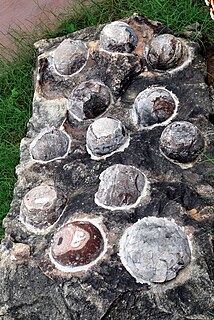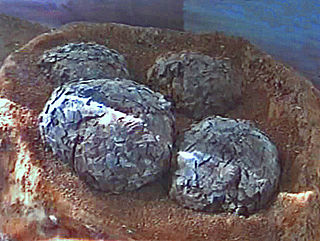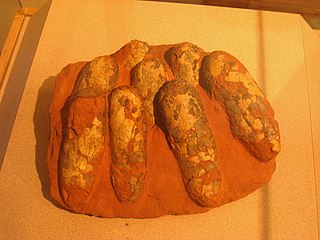
Dinosaur eggs are the organic vessels in which a dinosaur embryo develops. When the first scientifically documented remains of dinosaurs were being described in England during the 1820s, it was presumed that dinosaurs had laid eggs because they were reptiles. In 1859, the first scientifically documented dinosaur egg fossils were discovered in France by Jean-Jacques Poech, although they were mistaken for giant bird eggs. The first scientifically recognized dinosaur egg fossils were discovered in 1923 by an American Museum of Natural History crew in Mongolia. Since then many new nesting sites have been found all over the world and a system of classification based on the structure of eggshell was developed in China before gradually diffusing into the West. Dinosaur eggshell can be studied in thin section and viewed under a microscope. The interior of a dinosaur egg can be studied using CAT scans or by gradually dissolving away the shell with acid. Sometimes the egg preserves the remains of the developing embryo inside. The oldest known dinosaur eggs and embryos are from Massospondylus, which lived during the Early Jurassic, about 190 million years ago.

Cairanoolithus is an oogenus of dinosaur egg which is found in Southwestern Europe. The eggs are large and spherical. Their outer surface is either smooth, or covered with a subdued pattern of ridges interspersed with pits and grooves. Multiple fossil egg clutches are known but the nest structure is unclear.

Megaloolithus is an oogenus of dinosaur egg. Some eggs belonging to this oogenus may have been laid by the titanosaur Hypselosaurus. They are known for having thick eggshells, at least 1.5 millimetres (0.059 in) thick, and the nearly spherical shape of the eggs. They are primarily found in India and Europe, but some specimens have been found in South America.
Sphaerovum is an oogenus of dinosaur egg.
Shixingoolithus is an oogenus of dinosaur egg from the Cretaceous of Nanxiong, China.

Macroolithus is an oogenus of dinosaur egg belonging to the oofamily Elongatoolithidae. The type oospecies, M. rugustus, was originally described under the now-defunct oogenus name Oolithes. Three other oospecies are known: M. yaotunensis, M. mutabilis, and M. lashuyuanensis. They are relatively large, elongated eggs with a two-layered eggshell. Their nests consist of large, concentric rings of paired eggs. There is evidence of blue-green pigmentation in its shell, which may have helped camouflage the nests.
Phaceloolithus is an oogenus of dinosaur egg found in the Dongting basin of the Hunan Province of China. The eggs have a subspherical shape, measuring up to 168 mm on the long axis, and having a very thin shell.
Ageroolithus is an oogenus of dinosaur egg. It may have been laid by a theropod.
Dispersituberoolithus is an oogenus of fossil egg, which may have been laid by a bird or non-avian theropod.

Egg fossils are the fossilized remains of eggs laid by ancient animals. As evidence of the physiological processes of an animal, egg fossils are considered a type of trace fossil. Under rare circumstances a fossil egg may preserve the remains of the once-developing embryo inside, in which case it also contains body fossils. A wide variety of different animal groups laid eggs that are now preserved in the fossil record beginning in the Paleozoic era. Examples include invertebrates like ammonoids as well as vertebrates like fishes, possible amphibians, and reptiles. The latter group includes the many dinosaur eggs that have been recovered from Mesozoic strata. Since the organism responsible for laying any given egg fossil is frequently unknown, scientists classify eggs using a parallel system of taxonomy separate from but modeled after the Linnaean system. This "parataxonomy" is called veterovata.
Laevisoolithidae is an oofamily of fossil egg belonging to the Ornithoid-ratite Morphotype. Their eggshells are smooth and very thin, typically less than a millimeter thick. Laevisoolithids may be the eggs of Enantiornithid birds.

Egg paleopathology is the study of evidence for illness, injury, and deformity in fossilized eggs. A variety of pathological conditions afflicting eggs have been documented in the fossil record. Examples include eggshell of abnormal thickness and fossil eggs with multiple layers of eggshell. The identification of egg paleopathologies is complicated by the fact that even healthy eggs can be modified during or after fossilization. Paleontologists can use techniques like cathodoluminescence or thin sectioning to identify true paleopathologies in fossil eggs. Despite the diversity of paleopathologies known from fossil eggs, the vast majority of conditions known to afflict modern eggs have not yet been seen among fossils.

Egg taphonomy is the study of the decomposition and fossilization of eggs. The processes of egg taphonomy begin when the egg either hatches or dies. Eggshell fragments are robust and can often travel great distances before burial. More complete egg specimens gradually begin to fill with sediment, which hardens as minerals precipitate out of water percolating through pores or cracks in the shell. Throughout the fossilization process the calcium carbonate composing the eggshell generally remains unchanged, allowing scientists to study its original structure. However, egg fossils buried under sediments at great depth can be subjected to heat, pressure and chemical processes that can alter the structure of its shell through a process called diagenesis.
Parvoblongoolithus is an oogenus of fossil dinosaur egg whose small size and unusual shape suggest the possibility that it is a dwarf egg.
Hemifaveoloolithus is an oogenus of fossil dinosaur egg from the Tiantai basin in Zhejiang Province, China. It is a faveoloolithid, having spherical eggs roughly 13 cm in diameter. The shell is distinctive for being composed of four or five superimposed layers of shell units, and the honeycomb-like arrangement of pore canals.
Tipoolithus is an oogenus of fossil egg native to the Irbzer Formation in Morocco. Its classification is uncertain, but it most closely resembles Laevisoolithids, and like members of that oofamily, it was laid by an enantiornithine bird or small theropod.

Elongatoolithidae is an oofamily of fossil eggs, representing the eggs of oviraptorosaurs. They are known for their highly elongated shape. Elongatoolithids have been found in Europe, Asia, and both North and South America.
Dictyoolithidae is an oofamily of dinosaur eggs which have a distinctive reticulate organization of their eggshell units. They are so far known only from Cretaceous formations in China.
Incognitoolithus is an oogenus of medioolithid fossil bird egg. It is notable for bearing evidence of predation, possibly from a bird pecking the eggshell.

Gobioolithus is an oogenus of fossil bird egg native to Mongolia. They are small, smooth-shelled, and elongated eggs that were first discovered in the 1960s and early 70s during a series of fossil-hunting expeditions in the Gobi desert. Two oospecies have been described: Gobioolithus minor and G. major. The eggs were probably laid in colonial nesting sites on the banks of rivers and lakes.

The International Standard Book Number (ISBN) is a numeric commercial book identifier which is intended to be unique. Publishers purchase ISBNs from an affiliate of the International ISBN Agency.
The Journal of Vertebrate Paleontology is a bimonthly peer-reviewed scientific journal that was established in 1980 by Jiri Zidek. It covers all aspects of vertebrate paleontology, including vertebrate origins, evolution, functional morphology, taxonomy, biostratigraphy, paleoecology, paleobiogeography, and paleoanthropology. The journal is published by Taylor & Francis on behalf of the Society of Vertebrate Paleontology. According to the Journal Citation Reports, the journal has a 2017 impact factor of 2.190.








